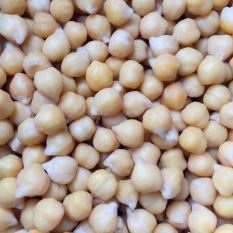This past weekend, my local SCA group held a big event – the investiture of our new baron and baroness. Because the king and queen of the East were there, there also were a looooooot of people attending at least for the day, to see the ceremonies, etc.

Image of cooked chickpeas from gettystewart.com, http://www.gettystewart.com/cook-chickpeas-soaking-storing-freezing/
That meant about 200 people to feed during the day, and I pitched in to produce some food for the dayboard. Looking for something vegetarian/vegan, I looked at cicera fracta, a 13th century Italian recipe from the Liber de Coquina. The cookbook was written by someone around Naples in the 13th century; there is a theory by the linguist Anna Martellotti that the Liber and another southern Italian medieval cookbook, the Anonimo Merdionale of the 15th century, have recipes that originally derive from the court of Frederick II of Italy. Frederick’s mother Constance was the daughter of Roger II of Sicily, and Frederick spent his childhood in the Arabicized Palermo court, and as emperor had many Muslims among his soldiers and personal retainers. There is also her theory that his personal cook, Berardo, was the originator of some of these recipes in both books. If you’re curious about the Anonimo Meridionale recipes, David and Rebecca Friedman have translated Libre B of the Meridionale and redacted some recipes.
Here is the recipe for cicera fracta:
Item, aliter : accipe cicera fracta et pone ad decoquendum cum oleo, pipere et safrano et cum caseo detruncato et ovis perditis et ovis debatutis; uel aliter, cum ciceris fractis et perbullitis et, aqua bullitionis eiecta, ponatur cepa frissa et bene confecta cum lardo uel oleo sicut dies exigit.
Crudely translated, it’s a chickpea porridge either flavored with oil, saffron, pepper, cheese, and crumbled hardboiled eggs, or oil, bacon (technically lardo), and onions.
There’s also another version in which the chickpeas are cooked in almond milk, with saffron and ginger.
Well, neither version of the first cicera fracta recipe would really do for vegans/vegetarians; the second cicera fracta recipe, while vegetarian, didn’t appeal to me. Also there are people with severe nut allergies who attend events, and I didn’t want an open crockpot of almond milk stew to be aerosolized death for them.
Having no saffron in the house and no chance to get more before the event, I went rooting among my medieval spices and found my grains of paradise and my cubebs.
Although grains of paradise were present in medieval Arabic cooking and perfume making, they were unknown (or rather forgotten about) in Europe when the Liber de coquina was written. Cubebs were known but they and grains of paradise were considered “hot,” humorally speaking, so I would have been a very irresponsible cook in medieval times. And I added white pepper too!
So this is what I wound up doing: I soaked 2 pounds of dried chickpeas overnight, and then in the morning, I boiled the chickpeas for a few hours, in water in a large stockpot, until they began to get soft. I then added sea salt, 1.5 teaspoons of grains of paradise, ground to a powder; 1.5 teaspoons of cubebs, ground to a powder; and about the same of white pepper. I boiled the whole thing a few hours more, and then caramelized in olive oil four medium onions, slivered. Once the onions were ready I dumped them into the pot and simmered for about 15 minutes, then dipped out about half of the chickpeas and onions into my mixer bowl, and using my stick blender to puree it. I pureed about half of stew again after returning the first batch of pureed chickpeas and onions to the pot. Then I simmered the mixture to thicken it a bit more.
The resulting effort was hearty, and the sweetness of the onion counterbalanced the sharpness of the spices used. I was told several times by people, “I don’t like chickpeas, but I like this!”
I’ve made the bacon and onion version before and lots of people who like bacon like that, because, well, bacon. Though I want to try it with lardo, if I can get my hands on any. I’ll try prosciutto or speck as well.
The saffron, cheese, and egg one…I don’t think it should be a melty cheese; I think it calls for something very salty and strong, like feta or ricotta salata. The eggs, I would hardboil and then crumble on as a garnish, with more egg provided so diners can add what they wish. The same thing with the ricotta salata, adding some to the pot before serving and providing some on the side so diners can add what they wish.
I have to admit I am intrigued by the almond milk one; I wonder if I added sugar to it, how it would taste. Sweetened almond milk pottages are a staple of medieval cuisine after all. Looks like I am going to be giving an order soon to Nuts.com for some saffron (the best online source I have found for saffon, quality and prices are very good).
Pingback: Recovering from Al-Hafla (and sharing a few recipes) | siquillya